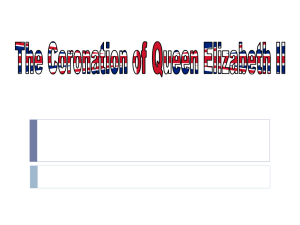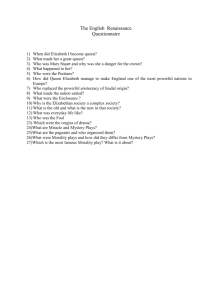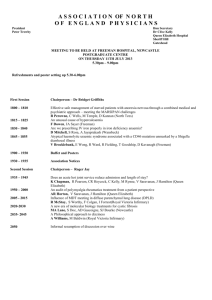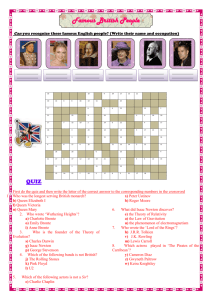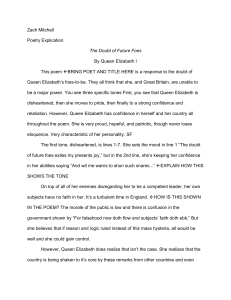The Coronation of Elizabeth Woodville Queen Consort
advertisement
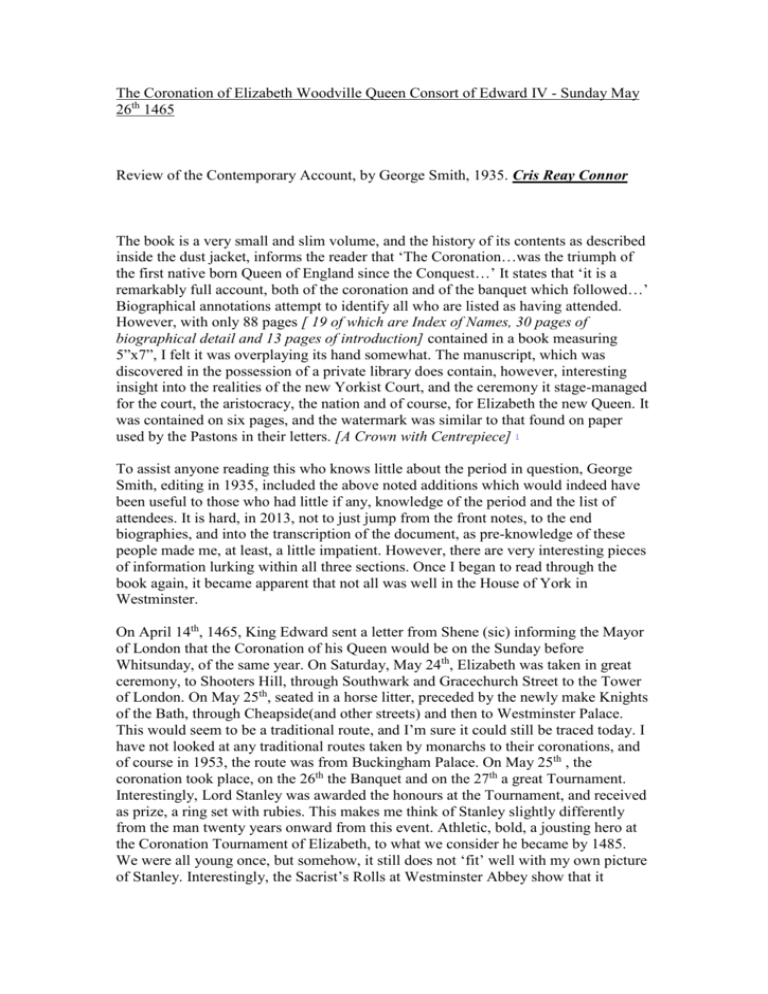
The Coronation of Elizabeth Woodville Queen Consort of Edward IV - Sunday May 26th 1465 Review of the Contemporary Account, by George Smith, 1935. Cris Reay Connor The book is a very small and slim volume, and the history of its contents as described inside the dust jacket, informs the reader that ‘The Coronation…was the triumph of the first native born Queen of England since the Conquest…’ It states that ‘it is a remarkably full account, both of the coronation and of the banquet which followed…’ Biographical annotations attempt to identify all who are listed as having attended. However, with only 88 pages [ 19 of which are Index of Names, 30 pages of biographical detail and 13 pages of introduction] contained in a book measuring 5”x7”, I felt it was overplaying its hand somewhat. The manuscript, which was discovered in the possession of a private library does contain, however, interesting insight into the realities of the new Yorkist Court, and the ceremony it stage-managed for the court, the aristocracy, the nation and of course, for Elizabeth the new Queen. It was contained on six pages, and the watermark was similar to that found on paper used by the Pastons in their letters. [A Crown with Centrepiece] 1 To assist anyone reading this who knows little about the period in question, George Smith, editing in 1935, included the above noted additions which would indeed have been useful to those who had little if any, knowledge of the period and the list of attendees. It is hard, in 2013, not to just jump from the front notes, to the end biographies, and into the transcription of the document, as pre-knowledge of these people made me, at least, a little impatient. However, there are very interesting pieces of information lurking within all three sections. Once I began to read through the book again, it became apparent that not all was well in the House of York in Westminster. On April 14th, 1465, King Edward sent a letter from Shene (sic) informing the Mayor of London that the Coronation of his Queen would be on the Sunday before Whitsunday, of the same year. On Saturday, May 24th, Elizabeth was taken in great ceremony, to Shooters Hill, through Southwark and Gracechurch Street to the Tower of London. On May 25th, seated in a horse litter, preceded by the newly make Knights of the Bath, through Cheapside(and other streets) and then to Westminster Palace. This would seem to be a traditional route, and I’m sure it could still be traced today. I have not looked at any traditional routes taken by monarchs to their coronations, and of course in 1953, the route was from Buckingham Palace. On May 25th , the coronation took place, on the 26th the Banquet and on the 27th a great Tournament. Interestingly, Lord Stanley was awarded the honours at the Tournament, and received as prize, a ring set with rubies. This makes me think of Stanley slightly differently from the man twenty years onward from this event. Athletic, bold, a jousting hero at the Coronation Tournament of Elizabeth, to what we consider he became by 1485. We were all young once, but somehow, it still does not ‘fit’ well with my own picture of Stanley. Interestingly, the Sacrist’s Rolls at Westminster Abbey show that it allowed the public to watch from the Belfry and they made a profit of £4. From the sale of sawn timbers used during the ceremony. However, Smith states that the list of officers present at the Coronation show that it was still possible to assemble those needed, even after a sustained period of Civil War. However, he then goes on to show almost the opposite. Although the Dukes of Norfolk and Oxford were present and carried out their hereditary offices of Marshal and Chamberlain, the young Dukes of Clarence and Buckingham (the latter had to be carried on the shoulders of henchmen to carry out his duties.) Buckingham should have been Constable, but at nine years old it was considered inappropriate and the Earl of Arundel doubled up on his duties as Butler with those of Constable. Precedent also had to be departed from, by the vacancy of the Bishopric of Bath. Durham and Bath should have walked on either side of the Queen, and Salisbury was elected to do that instead of Bath. Durham had been suspended for a time because of support to Henry VI, and perhaps Edward wished to bring him into the official, and very noticeable position at the Coronation. Rather like Oxford, who was to rebel later, he had been pardoned and ‘resumed’ his role in the hierarchy on processional duties. The great omissions are of course, Duchess Cecily of York, her eldest daughter Anne of Exeter and her youngest son, Richard of Gloucester. There can be no certainty as to why she was absent, other than that which we think we are aware of; that Cecily had disapproved strongly of the union between Edward and Elizabeth and that Richard at age 12 (13 in October) was still under her control. Anne was Duchess of Exeter, so I have no real basis to suppose that she did not wish to carry the train of her sister-inlaw, and Warwick was also absent. However, the rest of the family were out in some sort of force, with Edward’s other two sisters, Elizabeth and Margaret, and three of his aunts. Isabella his father’s sister, and two of Cecily’s sisters, Anne Duchess of Buckingham and Catherine Duchess of Norfolk. Throughout this, Elizabeth’s mother is named as Duchess of Bedford, and we should not forget that contemporaries would know that at one time Jacquetta was the first lady of the court in her younger days when married to Henry V’s brother John. It is now commonplace to disparage Elizabeth’s family, following the vitriol heaped upon her by Warwick and then by later generations who sought to denigrate the Yorkist Court; but her uncle was Jacques, Duc of Luxembourg. Her family was not as common as is always suggested. As the book continues the most interesting part begins on page 14 and ends on page 25 The tableau presented in the pages is incredible; you get a true flavour of the high ceremonial which was held at Westminster for the coronation. So for instance, Clarence as Steward of England, rode first, on a richly ‘trapped’ horse which was encased completely, from head to the ground, such trappings were richly embroidered with garnets and spangles of gold. The Earl of Arundel as dual Constable and Butler rode on his horse, trapped from head to the ground in cloth of gold. Not to be outdone, the Duke of Norfolk as Marshal, rode in the same fashion. Can you imagine the clamour, the noise, perhaps the trumpets which heralded such entrances? The great procession of office holders, then the Queen under a canopy. Clarence was again afforded a very important role by leading the Queen back into (the Monastery) of Westminster on foot, with Arundel and then the young Buckingham on a henchman’s shoulders, followed. There is a great deal of detail, which seems repetitive, but it does have a ring of authenticity about it, that the writer was actually present, watching the endless stream of noble ladies and Marshal and Constable and other dignitaries going to and fro. Some under canopies, some wearing scarlet, and at the end when the Queen went back into her chamber, she emerged wearing a new surcote of purple. There is also charming reference to Elizabeth taking off her crown and then putting in back on, all of which adds to the writer actually being at the ceremony, and then at the Banquet. There is an exact list of who sat at what table, extreme precedent of top table, The Queen’s mother and the other ladies, the clergy, the newly made Knights of the Bath, the Judges, the Mayor of London, Aldermen and other citizens. Although there is no list of actual dishes served at the Banquet, it would appear that there must have been tables ranged along each wall of Westminster Hall, and the main tables on a raised dais at the very top end of the Hall, it does seem as though the richly caparisoned horses, previously described, also made a ceremonial appearance in-between each course. There seems to have been rehearsed procession on horse and on foot, and the clamour, the uproar, and, I feel, the dirt, must have been an incredible spectacle. In these days of health and safety, of food hygiene and possible issues of food poisoning, I am picturing an incredible spectacle. The often quoted story that Jacquetta was made to kneel in front of her daughter the new queen cannot be true, another case of a scornful story about a haughty Elizabeth. Jacquetta would possibly have been trampled underfoot by one of the many richly caparisoned horses! Besides all of the incredible ceremony and the exact way to fold the Table Cloth in a reverend way, and the clear picture of it all, is the undeniable importance of George, Duke of Clarence. He appears in every part of the Ceremony and the Banquet, in the most honoured of places, carrying out very important ceremonial duties. He is the heir of his brother, Edward IV who, even though he had married Elizabeth in 1464, had not produced a child to supplant the young Duke. Not until November 1470 was a male heir born to Edward and Elizabeth, and with hindsight we may be able to grasp the dual use of this small chronicle. It illustrates, I believe, the incredible importance in which George was held, both by himself and by others. It was not make-believe either, as this document clearly shows, he was a very important constitutional member of the House of York. By the time George was serving as Steward of England at the Banquet, he had been the next in line to the throne since March 1461, and he had fleetingly been awarded the Palatine of Chester, which was of course, the traditional landholding of the heir to the throne. However, he rebelled against all of that before Edward Prince of Wales (York) was born, allied himself with Warwick and was married to Isabel Neville. You have to ask, WHY? I suspect that a clue to this is also in the short manuscript. All the nobility, young or old, were married, especially the Woodvilles, even the young John Woodville to the much older Duchess of Norfolk. It is highly possible that George, with Warwick as a mentor of sorts, was easily drawn away from his brother in frustration. Here he was, a pre-eminent noble, of the royal house, heir to the throne, and he was being prevented from beginning his own dynasty. In time, Elizabeth of York would remain unmarried so that she could be a perfect political pawn and Mary the second of the York girls was kept as first reserve. Upon her death, Cecily Plantagenet took over that role. Although Mary was aged 14 when she died in 1482 so there had been no imperative to marry the slightly younger Cecily. The unmarried royal Plantagenets were stacking up. Even the King’s sister, 2 Margaret, was kept dangling in unmarried stasis until a Burgundian alliance was cemented in 1469. What was the tipping point for Clarence? Searching for information, I have found that the Burgundian alliance was first mooted in 1466, with Margaret’s proposed marriage to Charles and George of Clarence would marry Charles’ daughter Mary. These did not go ahead, and eventually, Charles did marry Margaret, but Clarence would not get his great foreign prize. The great rift between Warwick and Edward IV took place in 1467, with Warwick openly hostile, and indeed Warwick had to issue a denial to Edward IV that he was in alliance with the Lancastrian faction. Clarence was also denied the opportunity to marry Isabel, Warwick’s elder daughter in 1467. The reality that all of Elizabeth’s siblings, her two older [Grey] sons and most of the nobility, were already married, perhaps compounded George’s sense of importance and his isolation from real power. Even the young Duke of Buckingham, who had to be carried on the shoulders of a henchman was married. As the table linen was being folded and returned to storage, and the wood was being sawn into saleable pieces, George must have believed himself to be rising as high as his brother. He never grasped, perhaps, that he could only ever be as high as his brother allowed. So, in conclusion, I have loved this little book, which initially looked as though it would be just a few pages of transcription, with bits and pieces about the background to the Civil War of the 1450s and then ( oh yawn…) biographies of people I recognise. How wrong I was. In fact, I shall read through it again before I send it back to the library. Cris Reay Connor 1 …’On the last page is written the name “Edward Lloyd Vohen”…possibly the earliest possessor of the record, and an ancestor of the family in whose Library it remained … until it was acquired’ (by George Smith) I have been unable to find any reference to this Edward or his family, or in fact verify the transcription. 2 Cecily was married to Ralph Scrope of Upsal during the reign of Richard III, the marriage was annulled in York upon Henry VII’s accession and she was married to Lord Welles, Henry’s step-uncle.

